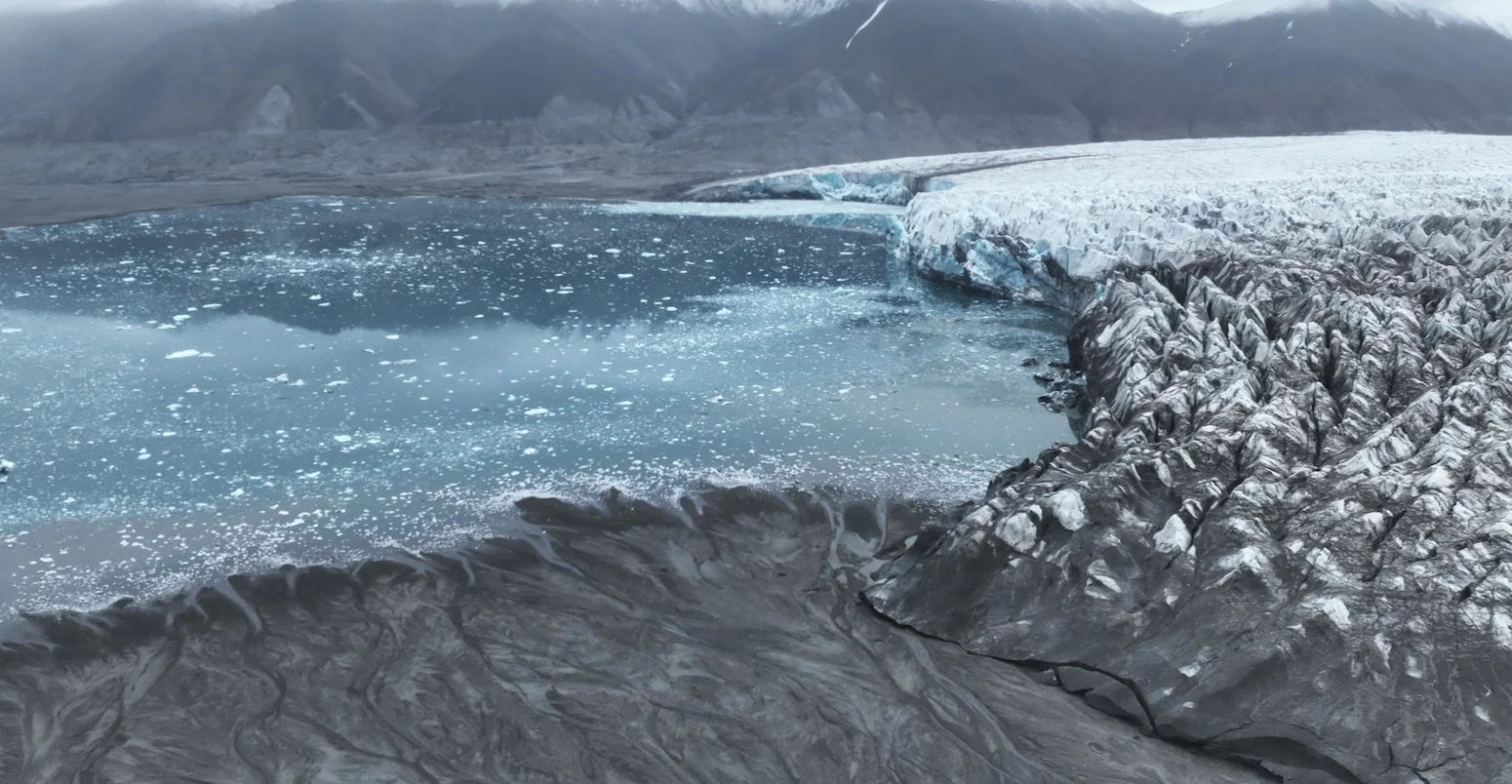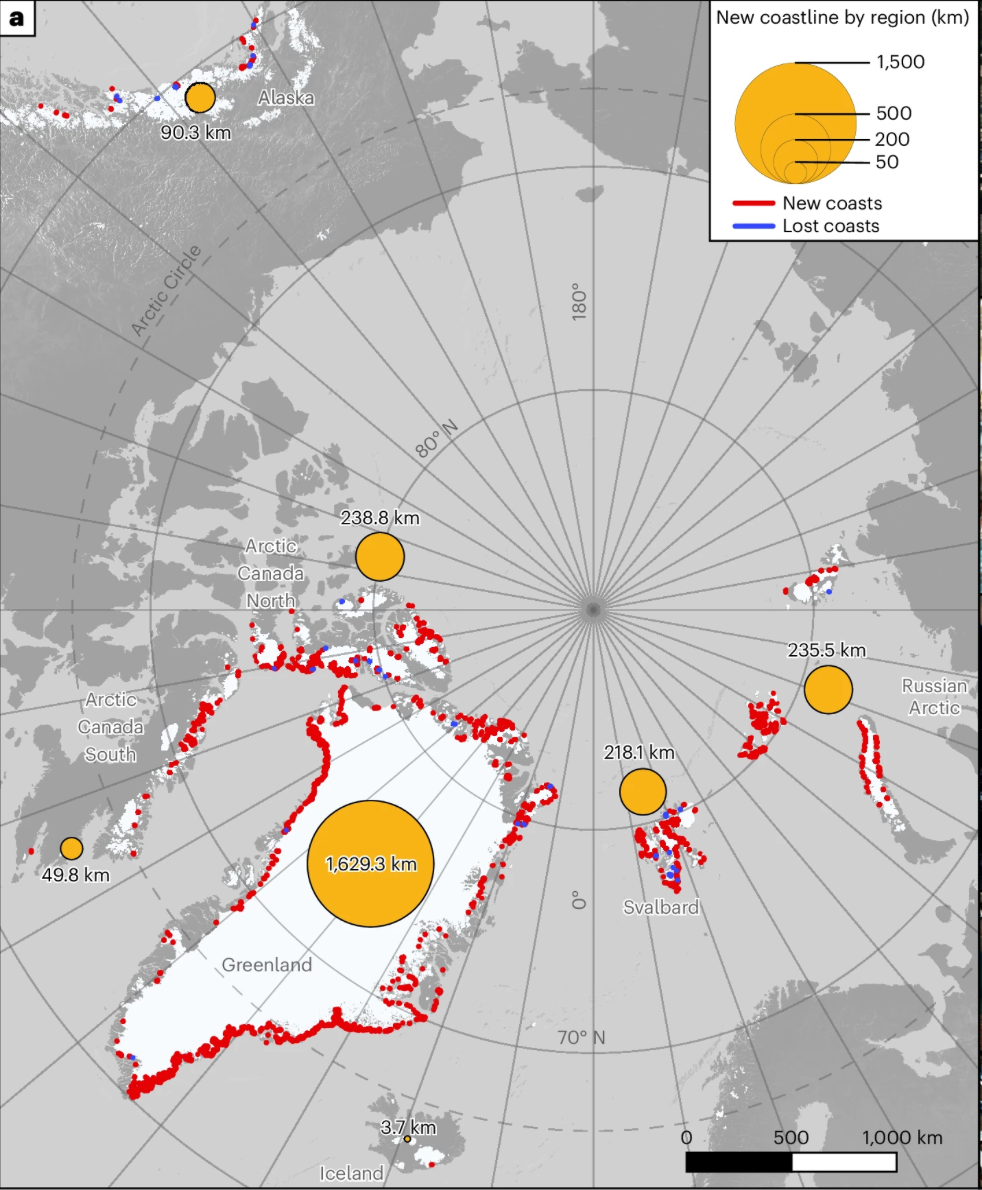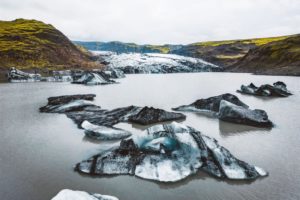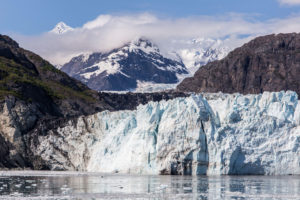
Global warming is ‘exposing’ new coastlines and islands as Arctic glaciers shrink
Ayesha Tandon
04.01.25Ayesha Tandon
01.04.2025 | 2:45pmRetreating glaciers created 2,500km of “new” coastline and 35 “new” islands in the Arctic between 2000 and 2020, according to a new study.
The research uses satellite images of more than 1,700 glaciers in Greenland, Alaska, the Canadian Arctic, Russian Arctic, Iceland and Svalbard.
The findings show that 85% of these glaciers retreated over 2000-20, revealing 123km of new coastline per year on average.
The study, published in Nature Climate Change, links the acceleration in glacier melt to warmer ocean and air temperatures.
The authors find that just 101 glaciers – less than 6% of the total – were responsible for more than half of the total additional coastline length.
For example, the retreat of the Zachariae Isstrom glacier in north-east Greenland revealed 81km of new coastline alone.
The study warns that the freshly revealed coastlines are more prone to landslides, which may, in turn, create “dangerous tsunamis” that pose risks to human life and infrastructure.
A scientist not involved in the study tells Carbon Brief that it remains “unclear” what the implications of the new coastlines will be for the people and ecosystems of the Arctic.
He suggests that they “may become home to important ecosystems that play a hitherto unquantified role in the global carbon cycle”.
Glacier melt
Glaciers are slow-moving rivers of ice found on almost every continent in the world. They typically advance downhill by a few centimetres every day, driven by their own weight.
The head of a glacier is always found on land – typically at high altitude, where temperatures are low. Here, precipitation and avalanches cause snow to build up on the surface of the glacier. Over time, the snow compacts into ice, adding mass to the glacier.
Meanwhile, the tail end of the glacier is typically found at lower elevations where the air is warmer. Here, melting ice and evaporating water cause glaciers to lose mass.
As the planet warms, glaciers are melting more rapidly. This often causes the bottom of the glacier – known as the “terminus“, “snout” or “toe” – to recede, reducing the overall length of the glacier. This is known as terminus retreat.
Over 2000-19, glaciers collectively lost around 267bn tonnes (gigatonnes, or Gt) of ice every year. A recent report by the UN warned that many glaciers will “inevitably” disappear entirely over the coming decades.
A separate study estimated that even if the world successfully limits global warming to 1.5C, glaciers could lose a quarter of their total mass by 2100.
Glaciers can be broadly split into categories based on their location. For example, while “land-terminating” glaciers end on land, “marine-terminating” glaciers flow into the ocean, where they often end in a “floating glacier tongue” that sits on the surface of the water.
When marine-terminating glaciers melt and retreat, new areas of coastline are often revealed. Research shows that marine-terminating glaciers in the northern hemisphere have cumulatively lost 10Gt of mass every year over 2000-20 due to terminus retreat.
The northern hemisphere is home to around 1,500 of the world’s roughly 200,000 glaciers.
The new study assesses how much new coastline has been exposed due to terminus retreat in marine-terminating glaciers in the northern hemisphere over 2000-20.
Satellite monitoring
The authors used a pre-existing dataset to identify all the marine-terminating glaciers in the northern hemisphere. They then manually assessed satellite imagery – mainly from Sentinel-2 – to digitise the new coastline that was exposed as a result of glacier retreat around Greenland, Alaska, the Canadian Arctic, Russian Arctic, Iceland and Svalbard over 2000-20.
Dr Jan Kavan is the lead author of the study and a researcher at the University of South Bohemia’s Centre for Polar Ecology. He tells Carbon Brief that the researchers opted for a manual approach because algorithms trained to identify the position of glaciers “don’t work very well” on coastlines.
This is because Arctic coastlines tend to be highly variable, Kavan explains. For example, glaciers near the coastline may be covered in debris – making it hard for an algorithm to recognise them.
Dr Simon Cook is a senior lecturer in environmental sciences at the University of Dundee, who wrote a “news and views” piece about the study published in Nature climate change. He praises the study, telling Carbon Brief that manually identifying coastlines is “labour-intensive and slow work, but widely regarded to be robust”.
The authors inspected 1,704 marine-terminating glaciers in total. They find that 2,466km of new coastline formed between 2000 and 2020 – an average of 123km of new coastline every year.
The map below shows where the coastline was added (red) and lost (blue) due to changes in glacier terminus positions over 2000-20. The yellow circles the total length of new coastline added in different regions, where larger circles indicate greater additions.

The authors note that the rate of new coastline formation varies highly between regions. Just 101 glaciers were responsible for more than half of the total additional coastline length, they say.
Two-thirds of the new coastline identified in this study were in Greenland, the authors say. The melt of the Zachariae Isstrom glacier in north-east Greenland has resulted in the formation of 81km of new coastline – more than twice as much as any other glacier in the study – according to the paper.
Retreating glaciers also exposed 35 new islands with areas larger than 0.5 square kilometres (km2), according to the study.
Changing coastlines
Rising ocean and air temperatures are the main reason that marine-terminating glaciers are rapidly losing mass, the study says. However, many other factors may affect how quickly new coastline forms due to glacier melt.
According to the authors, 85% of the glaciers in the study retreated between 2000 and 2020.
However, not all of these led to the development of new stretches of coastline.
For example, glaciers that stretch out far into the sea could experience “extensive retreat” without any new coastline forming, according to the paper.
Conversely, glaciers in “deep and narrow fjords” can expose long new areas of coast by losing only a small volume of ice.
The authors note that the most “dramatic” glacier retreats are due to ice shelves or floating tongues breaking off the main glacier and collapsing into the water.
Meanwhile, glacier advances – when glaciers gain mass more quickly then they lose it, or temporarily “surge” forwards – can cause a loss of coastline. (Surges are short-lived periods when the glacier moves faster than its normal rate, often due to meltwater which builds at the base of the glacier and acts as a lubricant.)
The paper finds that more than 50 metres of coastline was lost due to glacier advances. Two-thirds of this gain was in Svalbard due to a “surge” of the Nathorstbreen glacier system, according to the paper.
Lead author Kavan tells Carbon Brief that other studies have assessed coastline gain from “individual glaciers” or “small regions”, but says this is the first paper to quantify coastline gain across the entire northern hemisphere for a uniform time period.
Dr Robert McNabb, a lecturer at Ulster University who was not involved in the study, tells Carbon Brief the study “highlights the importance and immense value of having long-term, freely available satellite archives for research”.
Tsunami risk
Glacier melt is often discussed in the context of water security, as the world’s 200,000 glaciers store around 70% of the Earth’s fresh water. However, Kavan tells Carbon Brief that the impact of retreating glaciers on the bedrock is often “neglected”.
Using a map of rock types across the Arctic, the authors analyse the changing conditions of the new coastlines. They find that most of the new coastline is formed of metamorphic bedrock – a type of rock formed from intense heat and pressure. Meanwhile, softer sedimentary rocks, which are more susceptible to erosion, dominate the newly formed coastlines in eastern Svalbard.
In his news and views piece, Cook – the University of Dundee environmental sciences lecturer – explains that the newly revealed coastlines are known as “paraglacial”. He writes:
“Paraglacial coasts differ from other established areas of Arctic coastline because permafrost will not yet have had time to develop in these freshly revealed areas, meaning that they are more easily eroded by wave action, mass wasting and other processes because of a lack of icy cement. They are, therefore, expected to be highly dynamic.”
Cook says it is “currently unclear” what the implications of the new paraglacial coastlines will be for the people and ecosystems of the Arctic. He suggests that the new coastlines “may become home to important ecosystems that play a hitherto unquantified role in the global carbon cycle”.

Freshly revealed paraglacial coastlines can be more prone to landslides, which may, in turn, cause “dangerous tsunamis”, the paper notes. As an example, it points to a tsunami on 17 June 2017 in Greenland, which caused “substantial infrastructure damage and loss of life”.
Dr Anna Irrgang is a coastal geomorphologist at the Alfred Wegner Institute and was not involved in the study. She tells Carbon Brief that the study “may help in detecting potential risk-zones” for such tsunamis.
She adds that the dataset provided in this study can be used as a “first estimation of the hazard potential”, but adds that “a more in-depth risk analysis needs to be undertaken at the local scale, where communities might be exposed to these arising dangers”.
Meanwhile, Kavan tells Carbon Brief that marine-terminating glaciers are considered “biodiversity hotspots”. Meltwater from the glacier causes upwellings at the terminus of the glacier, creating “nutrient-rich water” that is vital for many polar species, he says.
As a result, ongoing glacier retreat may result in many of these habitats being lost, putting species like bearded seals and Arctic-dwelling birds at risk, he adds.
Kavan, J. et al. (2025) New coasts emerging from the retreat of northern hemisphere marine-terminating glaciers in the twenty-first century, Nature Climate Change, doi:10.1038/s41558-025-02282-5





